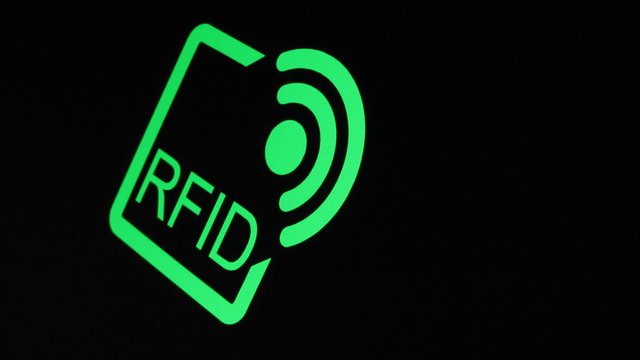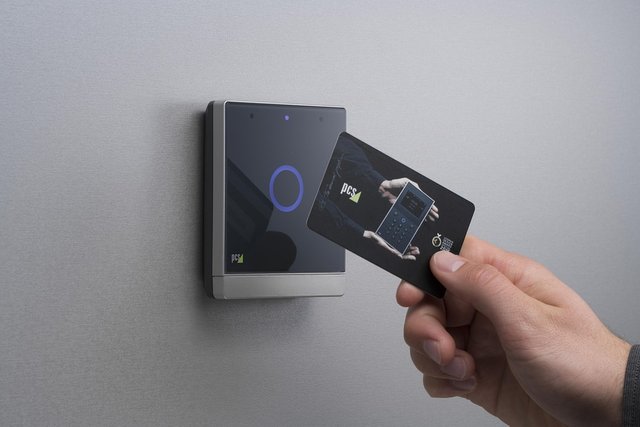What is RFID technology and how it works?
RFID is an acronym for "Radio-Frequency Identification" and refers to a technology in which digital data encoded in RFID tags or smart labels (defined below) is captured via radio waves by a reader .
The RFID device serves the same purpose as a bar code or a magnetic strip on the back of a credit card or ATM card; It provides a unique identifier for that object. And, as bar codes or magnetic strips are scanned to obtain information, RFID devices are scanned to retrieve the information that identifies them.
RFID is similar to barcoding that captures data from a device with a tag or label and stores it in a database.
However RFID systems have several advantages over those using barcode asset tracking software. Most notable is that RFID can read data from the tag out of line-of-sight, while the barcode must be aligned with the optical scanner.

Source
RFID works better than barcode
An important advantage of RFID devices compared to other barcode methods is that the RFID device does not need to be properly positioned from the scanner. We are aware of all the difficulties when the checkout clerk of the store sometimes has to place the barcode in front of the scanner to ensure that the barcode can be read properly. And, of course, credit cards and ATM cards must be swiped through special riders.
In contrast, RFID device scanners operate within a few feet (up to 20 feet for high-end devices). For example, you can put all your groceries or purchases in a bag, and set the bag on a scanner. The RFID device will be able to scan all these accessories.
RFID technology was available fifty years ago. Recently it has been found that the ability to manufacture RFID devices has fallen to the point where they can be used as "throwaway" lists or control devices.
Another reason why it took so long for RFID to be in common use is the lack of standard in the industry. Most companies investing in RFID technology only use tags to track the objects under their control; Many benefits of RFID come when goods are tracked from company to company or country to country.

Source
RFID is the same as technology code. However, the RFID tag is not scanned directly, nor does the tag need to be in the line-of-site of its reader. The RFID tag must be within the range of the RFID reader, which can be 3 to 300 feet in distance for reading. RFID technology allows many objects to be quickly scanned and is able to quickly identify a particular product, even when it is surrounded by many other objects.
How does RFID work?
RFID belongs to a group of technologies referred to as an Automatic Identification and Data Capture (AIDC). AIDC methods automatically identify objects, collect data about them, and enter this data directly into the computer system with little or no human intervention.
The Radio-Frequency Identification System consists of three parts:
A scanning antenna
A transceiver with a decoder to interpret the data
A transponder - RFID tag - that is programmed with information.

Source
The scanning antenna sends radio frequency signals over a relatively small range. RF radiation does two things:
It provides a means of communication with the transponder (RFID tag) and
It provides RFID tag with energy for communication (in case of passive RFID tag).
It is a very important part of technology; The RFID tag does not require placing the battery, and therefore it can remain usable for long periods (perhaps decades).
Scanning antennas can be permanently affixed to the surface; Handheld antennas are also available. They can take any size you want; For example, you can create them in a door frame to retrieve data from passing persons or objects.
When an RFID tag passes through the area of the scanning antenna, it detects the activation signal from the antenna. He "wakes up" the RFID chip, and transmits information to his microchip to be captured by the scanning antenna.
In addition, RFID tags can be one of two types. The active RFID tag has its own power source; The advantage of these tags is that the reader can receive signals even when they are far away. Even though some of these devices are made of life span of 10 years, but RFID tag has limited life. However, Passive RFID tags do not require batteries and can be very short and have unlimited life.
RFID tags can be read in a wide variety of situations where barcodes or other optical reading technologies are useless. like -
The tag is not on the surface of the object.
The reading time is typically less than 100 milliseconds.
Instead of reading individual item tags, a large number of tags can be read simultaneously.

Source
Use of RFID technology
The ability to identify and track individual items, as well as commodity crates, without line-of-site, can be of benefit to almost any company. For example, if a company has 5,000 identical plastic pieces, an RFID tag can be placed on each to identify 3,097 to 1,948 crates without a line of sight. Identification of these crates can be important to the company's bottom line when someone takes an order from a valuable business or customer. That company is not only required to keep track of that trade or arrangement, but potentially also the crate, if it is one of the company's assets. RFID can be used to locate and track these assets.

Defended (50.00%)
Summoned by @georgia14
Sneaky Ninja supports @youarehope and @tarc with a percentage of all bids.
Everything You Need To Know About Sneaky Ninja
woosh